Finding the best yoga mat is crucial.
While you can easily get a cheap yoga mat at any big-box retailer, these low-quality mats tend to fall apart quickly or can get slippery when you sweat.
Even if you are a beginner or only an occasional yoga-goer, it’s worth your time to get a high-quality yoga mat.
We’ve looked in detail at the top options on the market right now; here are our top ten rankings.
1. Manduka PRO
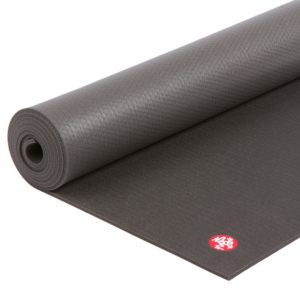
Click here for the lowest price on Amazon
Manduka makes a dense, incredibly strong yoga mat that’s widely lauded as one of the top models on the market. It comes in both a 75” and an 81” length, so it’s especially good if you are tall.
Users love its grip and its durability. The only drawback? All that toughness and durability means It’s very heavy!
2. Liforme Yoga Mat
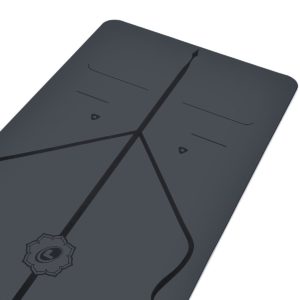
Click here for the lowest price on Amazon
Liforme makes an excellent yoga mat that’s well-suited for beginners and experts alike. Its 26 inch width is great if you have broad shoulders, and it features alignment markers to help you with your poses.
At 4 mm thick, it’ slim enough to give you a lot of stability for difficult poses. The durability and grip of a Liforme mat are legendary–daily use for years isn’t unheard of, and it’s well-suited for hot yoga.
3. Yogarat Pro
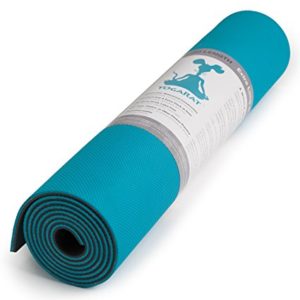
Click here for the lowest price on Amazon
Slim, lightweight, and springy, the Yogarat Pro is a popular choice among people who like to travel light. At 72 inches in length, it’s a good choice if you are taller than average, though it’s not quite as roomy as some of its other competitors.
At 5mm thick, it’s just cushioned enough to keep your feet happy, but not so mushy that you feel unstable.
4. Aurorae Synergy
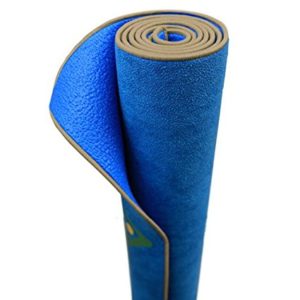
Click here for the lowest price on Amazon
Aurorae Synergy is specially designed for hot yoga. It’s double-sided; one side is a standard synthetic rubber, while the other is a firm, strong microfiber towel.
The two are bonded to each other, so no matter how hot and sweaty your yoga session gets, you won’t be slipping. The two-in-one design means it’s exceptional at hot yoga, but a bit lackluster at other practices.
It’s not the greatest for outdoor practice, as the microfiber towel will pick up leaves and twigs, and the Aurorae Synergy can be trickier to clean than a full synthetic mat. Still, for hot yoga, it’s hard to beat.
5. Suga Recycled Wetsuit Mat
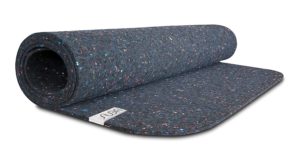
Click here for the lowest price on Amazon
Suga is a small company with a dedicated following that praises its closed-loop recycling practices. Its yoga mats are made from recycled surfing wetsuits, giving them a unique, grippy feel and good durability.
Because of this unusual material, they are somewhat heavier than a comparable mat of the same dimensions. The Suga mat is 5 mm thick, and at 25 inches wide, is just a bit roomier than average in the shoulders.
6. Hugger Mugger Ultra Nature Collection
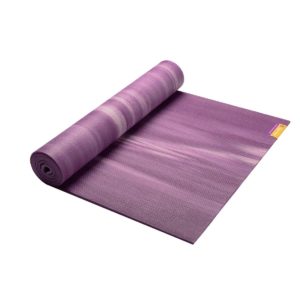
Click here for the lowest price on Amazon
Though it’s slim and a little restrictive in size, the tough, grippy surface and the antimicrobacterial treatment that Hugger Mugger applies to their yoga mat makes this a good choice for outdoor yoga.
It can handle rougher terrain than a cheaper yoga mat, and thanks to its synthetic design, isn’t going to break down because of heat or sunlight.
7. B Mat Everyday
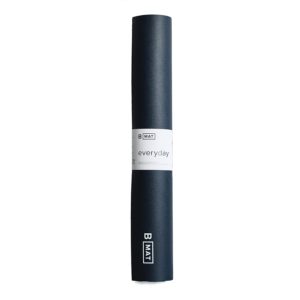
Click here for the lowest price on Amazon
The B Mat Everyday is made from natural rubber, and is one of the slimmest yoga mats you can get that will still hold up under regular use.
It’s only 4 mm thick, so if a thicker mat leaves you feeling unstable, the B Mat will be right up your alley.
It’s not the best when it comes to grip under sweaty conditions, so Bikram and hot yoga enthusiasts might want to look elsewhere.
8. Gaiam Ultra-Sticky Yoga Mat
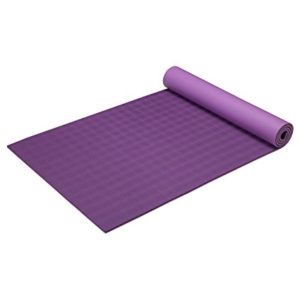
Click here for the lowest price on Amazon
Gaiam is well-known for reasonably priced yoga mats that are beginner-friendly and are perhaps the most common brand you’ll see at retail stores.
While their Ultra-Sticky mat is a step up from their introductory model, it still doesn’t score well with users. Despite the name, many people still find it very slippery for inversions and other tricky maneuvers.
9. prAna Indigena Natural Yoga Mat
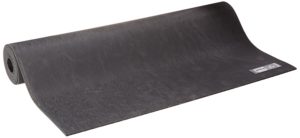
Click here for the lowest price on Amazon
prAna makes a 100% natural rubber mat that’s accessible and easy to find. The surface is very grippy, but the material is a bit flimsy, and as with other natural rubber mats, tends to deteriorate in direct sunlight.
Many users find that it has a distinctive rubbery smell, especially when you first start using it.
10. Jade Harmony
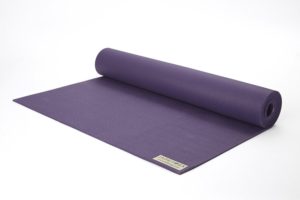
Click here for the lowest price on Amazon
Jade Harmony’s yoga mat is made from 100% natural rubber, with no synthetic ingredients. This has advantages and disadvantages–the natural rubber is very grippy, but this also necessarily means that the surface is rougher than most.
Another issue with the natural rubber composition is that it will break down over time if exposed to direct sunlight, so this is definitely not the mat for you if you want to do yoga outdoors.
Its open-cell construction also means that it absorbs sweat and dirt more readily, and is tougher to get clean.
Benefits of a quality yoga mat
In terms of the composition of the mat, you have two basic choices: natural rubber or a synthetic compound.
The thickness of your mat will dictate the degree to which it aids or hinders your balance, and the conditions in which you’ll be using your mat will affect whether you want an open cell or closed cell material.
Benefits
Before the most recent surge in yoga’s popularity, yoga mats were hard to find. Those that you could find were usually made with rubber. Now, there are a lot of alternatives, each of which has benefits and drawbacks.
Rubber (technically latex rubber) comes from the sap of the rubber tree, which is grown in the rainforest. As such, rubber is a natural material, though it can be toughened and improved with industrial processing.
Natural material enthusiasts will usually opt for a rubber yoga mat, though there are some important reasons you might want to consider an alternative.
First off is rubber’s resiliency. While it is naturally a very stretchy and springy material, it does not handle extremes of environment very well. Research on the chemistry of latex rubber demonstrates that the latex molecules tend to break down after exposure to ultraviolet light or heat (1).
This is not good news if you plan on doing yoga outdoors, or if you have a habit of leaving your yoga mat in your car while you are at work. Heat from a hot summer day can easily exceed 150 degrees fahrenheit, which will make short work of the latex molecules in your yoga mat after a few weeks of constant exposure (2).
Ultraviolet light is especially problematic, because the high-energy photons in from an ultraviolet light source–like the sun–constantly bombard the latex rubber molecules in a traditional yoga mat, which breaks down the molecular bonds that hold it together over time.
A third reason makes natural rubber an unattractive material for yoga mats for a small fraction of the population. About one percent of the general population is allergic to latex, but this number climbs much higher among people who are exposed to latex on a regular basis.
This can include doctors, nurses, and other healthcare professionals who wear latex gloves (3). Once your body develops a sensitivity to latex, you might find yourself getting redness, irritation, itching, or rashes from a latex rubber. If this is the case, you might want to opt for a synthetic mat.
For all three these reasons, many high-end yoga mats are not made from latex. A wide range of synthetic rubber substitutes are available, and each company usually has their own special formulation for optimal grip, durability, and springiness.
With some lower quality brands, there are concerns about “off-gassing”–this is the slow evaporation of volatile compounds that are a byproduct of the manufacturing process.
When you walk into a freshly-painted room and are overwhelmed by the sickly-organic smell, that’s off-gassing. Cheap, poorly-produced yoga mats can off-gas toxic compounds, since the materials that go into the mat are usually byproducts of petroleum processing.
Quality manufacturers will guarantee that there are no toxic or volatile compounds in their mats, so this is less of a concern.
Synthetic yoga mats usually feature “closed cell” construction, meaning that the microscopic foam cells that make up the mat are hermetically sealed–they are air and water-proof, so sweat and dirt won’t get inside the mat (4).
This contrasts with a natural rubber mat, which is often open cell foam. These do tend to soak up sweat, making them get dirtier easier and more difficult to clean and dry.
With a closed cell mat, cleanup is easy as a simple wipe-down. However, the open-cell construction of a natural rubber mat (as well as a handful of synthetic mats) does tend to make them grippier under hot and sweaty conditions.
High-quality synthetic mats can usually match this with special treatments that make their materials equally grippy, but not all manufacturers can achieve this.
In terms of thickness, there’s a tremendous range of options, from thin and firm 3 to 4 mm mats to cushy mats that are twice as thick or more.
Two factors are going to affect your level of comfort and your ability to perform on surfaces of different stiffnesses. The first is how well your body tolerates hard surfaces.
On the bottom surface of your foot (especially on your heel and around the ball of your foot) your body has deposits of fat that are explicitly for cushioning. However, the thickness of these pads varies across the population quite substantially (5).
Some people have well-cushioned feet, while others have relatively little fat, and the bony parts of their heel and the ball of the foot protrude more.
For those with less fat under their feet, they will be less able to tolerate a very thin yoga mat without getting foot pain, and may want to opt for something thicker.
As you get older, the thickness of these fat pads tends to shrink, so older yogis might want to gravitate towards a thicker mat too.
The tradeoff for more cushioning is slightly worse balance. There is a comprehensive body of scientific research into the effects of varying levels of underfoot cushioning on single leg balance, and it all indicates that a softer surface is more challenging for balance (6).
If you struggle already with single-leg poses, a thin mat might give you a leg up when it comes to improving your postural stability.
Recap
If you are serious about yoga–in fact, even if you are not serious about yoga–it’s worth your while to get a quality yoga mat.
The choices can seem overwhelming, but once you know how to navigate the difference between a rubber and a synthetic mat, a closed cell versus an open cell mat, and the benefits and tradeoffs that come with a thicker or a thinner mat, you’ll be well-equipped to make the right choice for you.
Most people will find that a synthetic yoga mat about 5 mm thick, made by a quality, reputable manufacturer, will suit their needs.
This type of yoga mat is usable by just about anybody in just about any situation. Ultra-thin, ultra-thick, and latex rubber mats definitely have their advantages in certain situations, but a synthetic middle of the road mat from a high-ranked company is a good place to start if you’re at a loss for where to begin.
https://bodynutrition.org/yoga-mat/
No comments:
Post a Comment